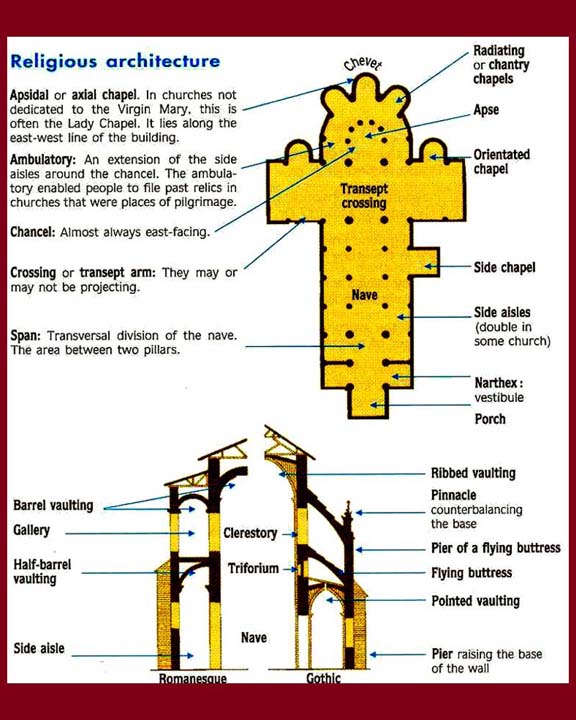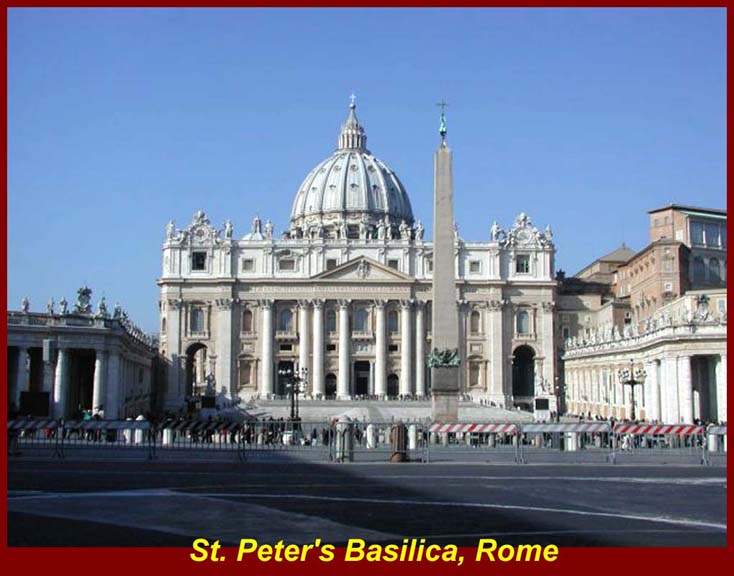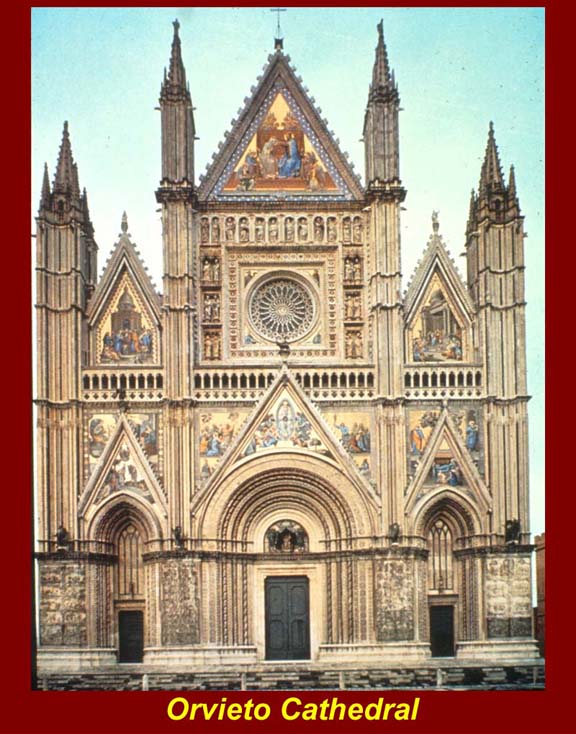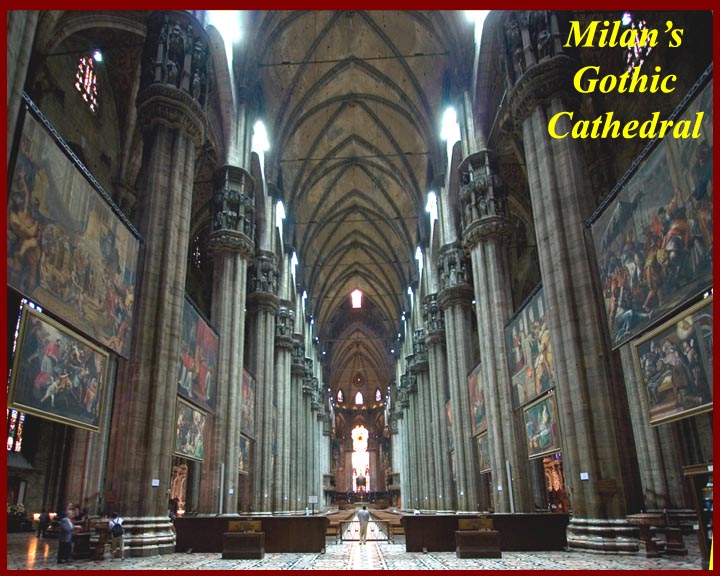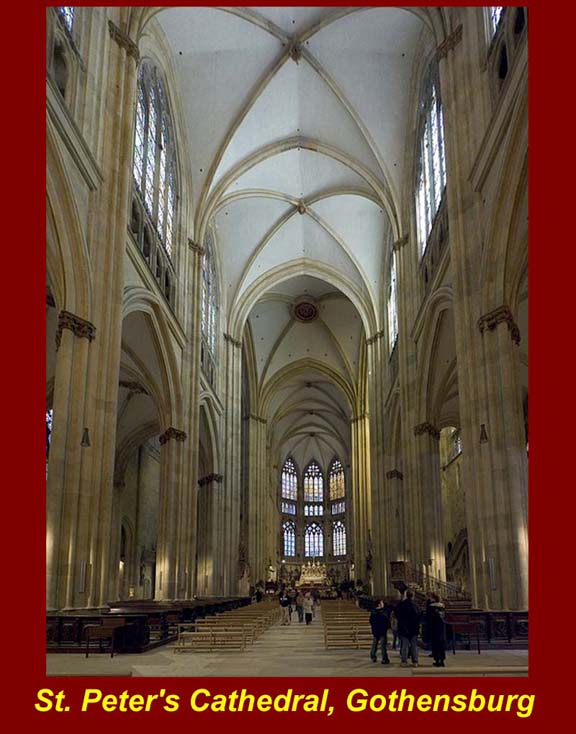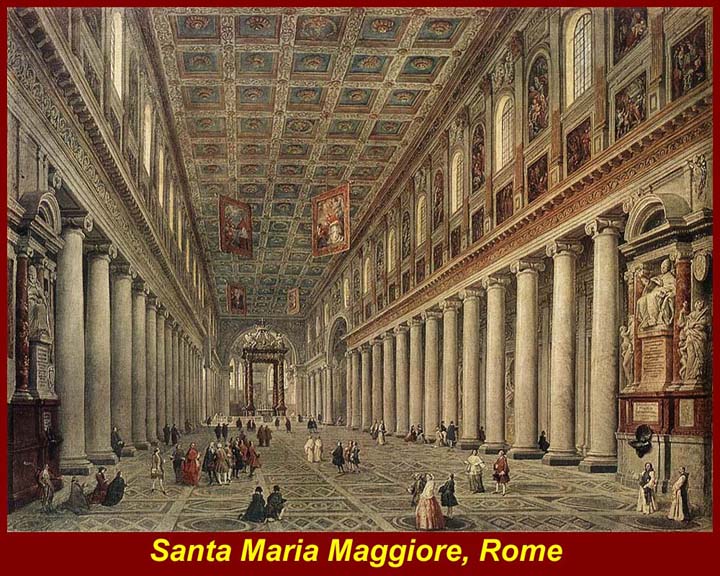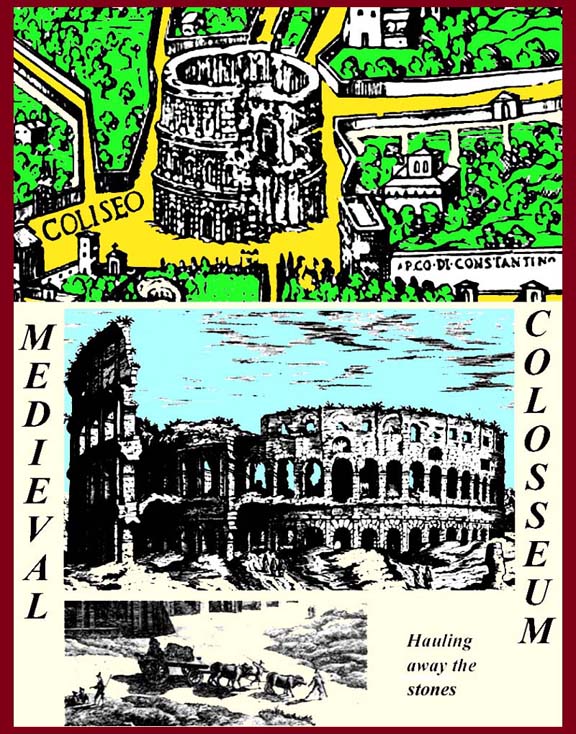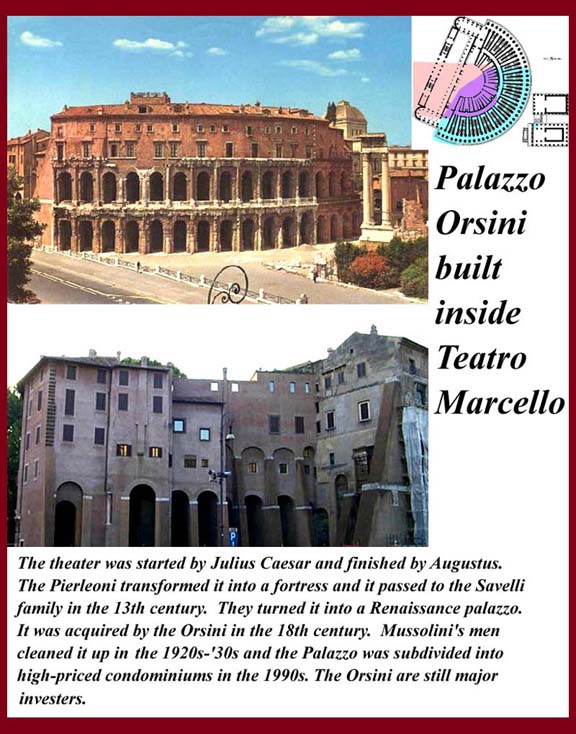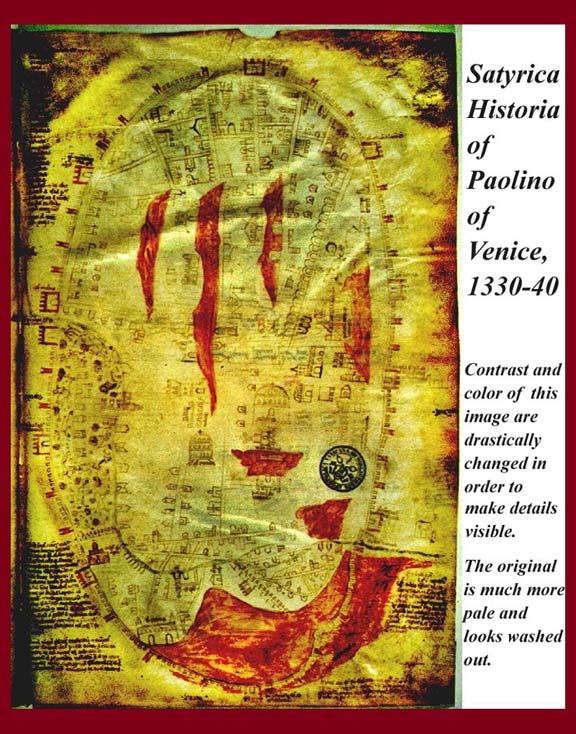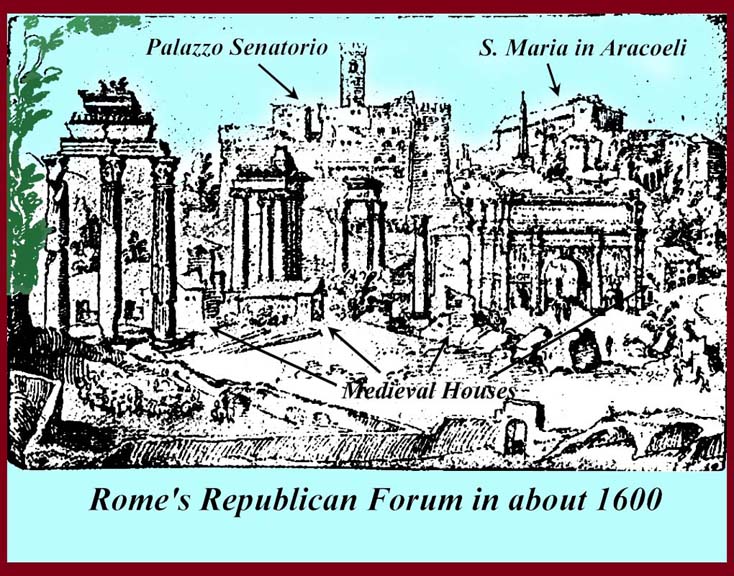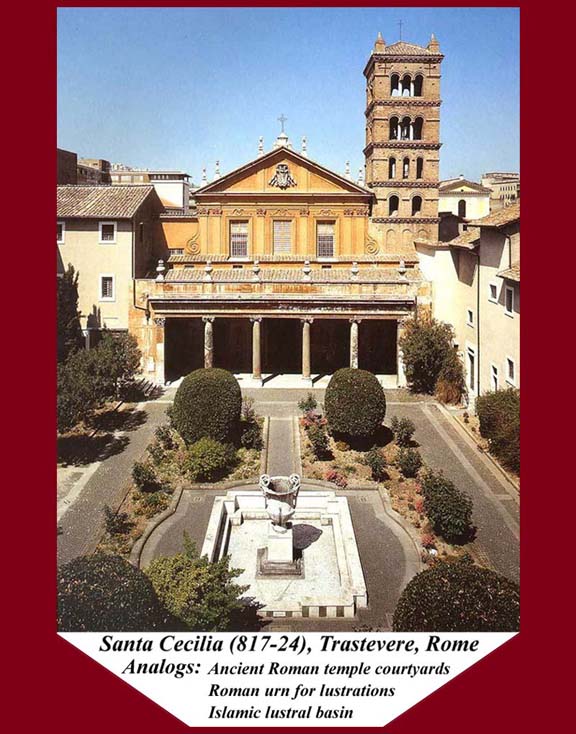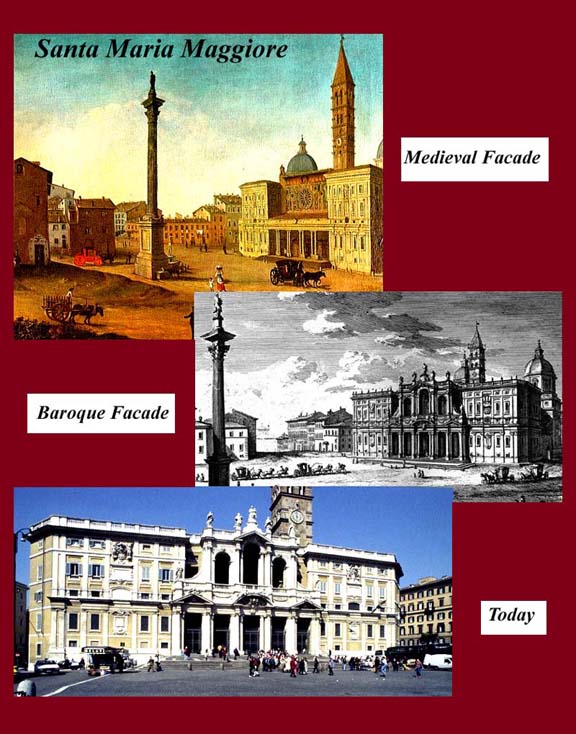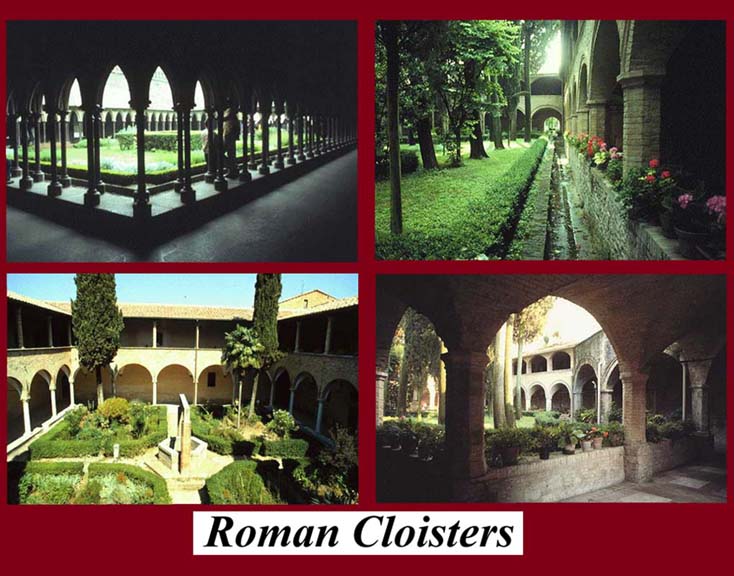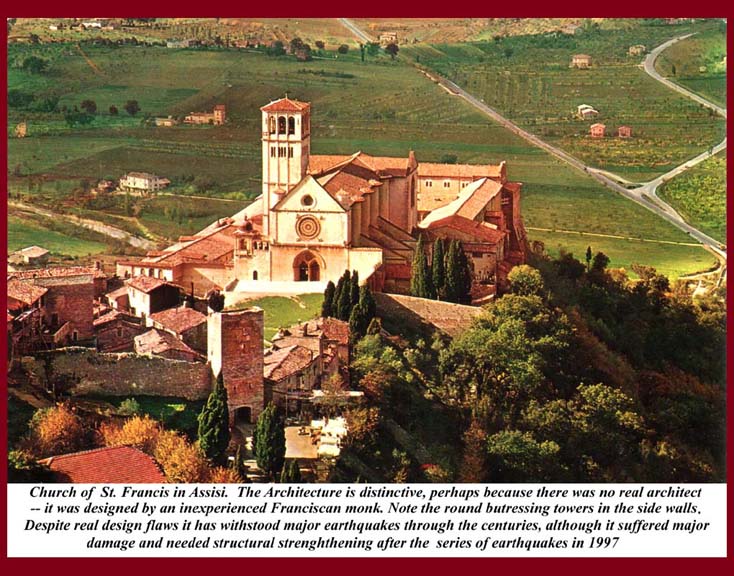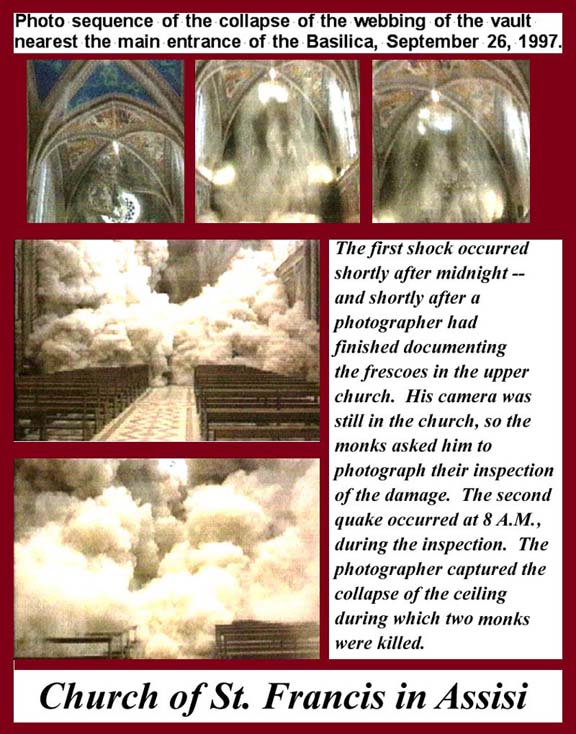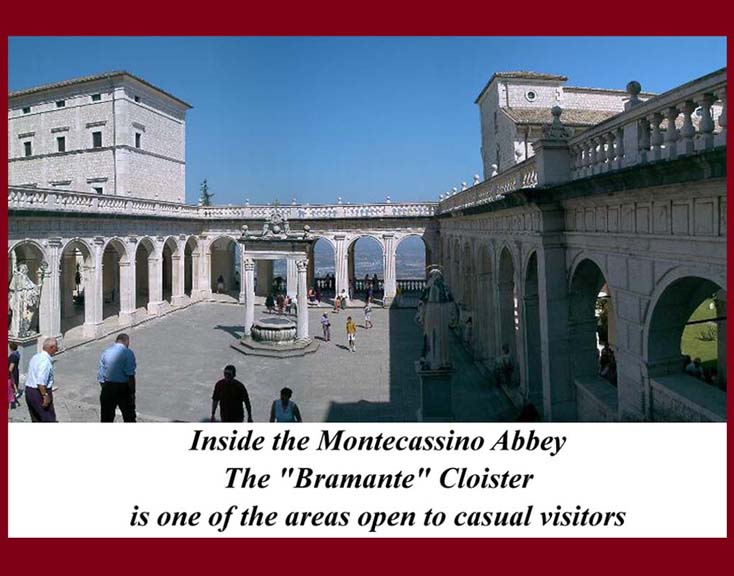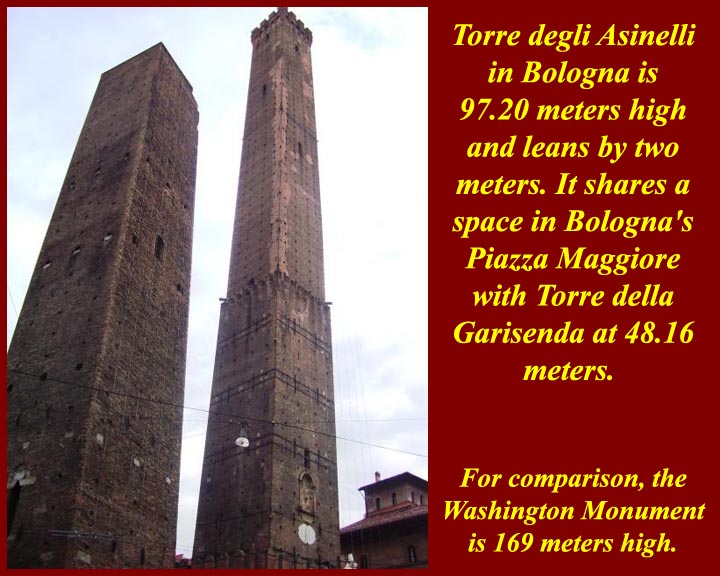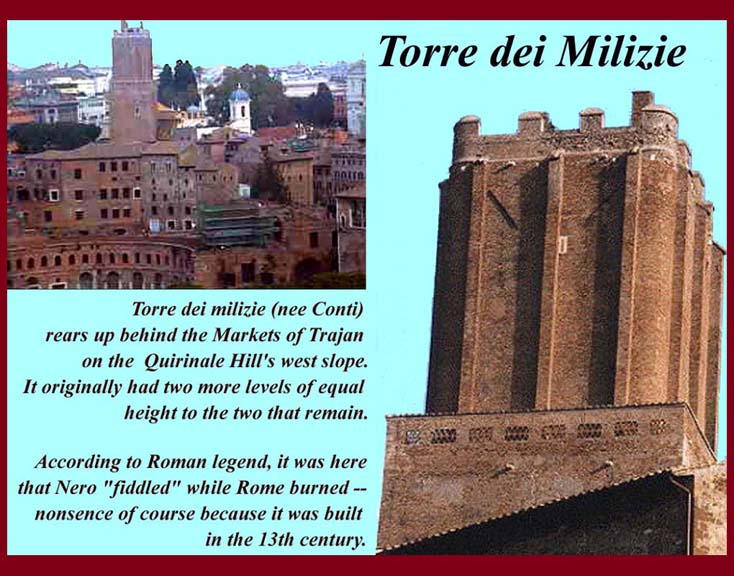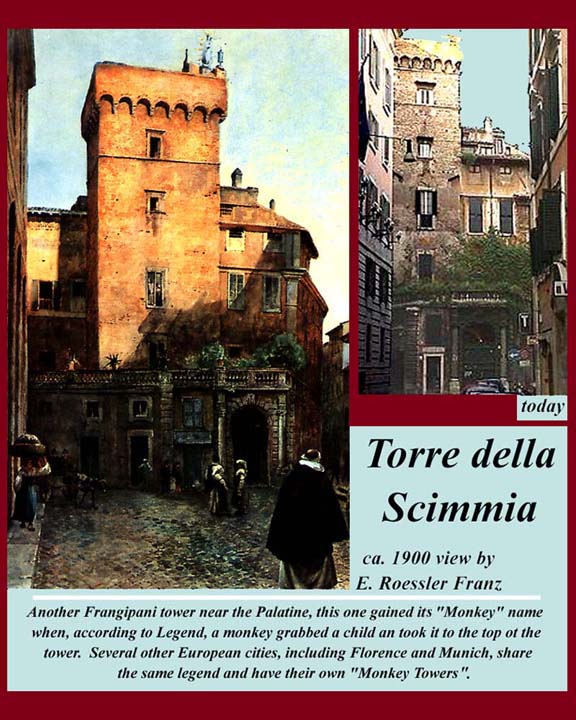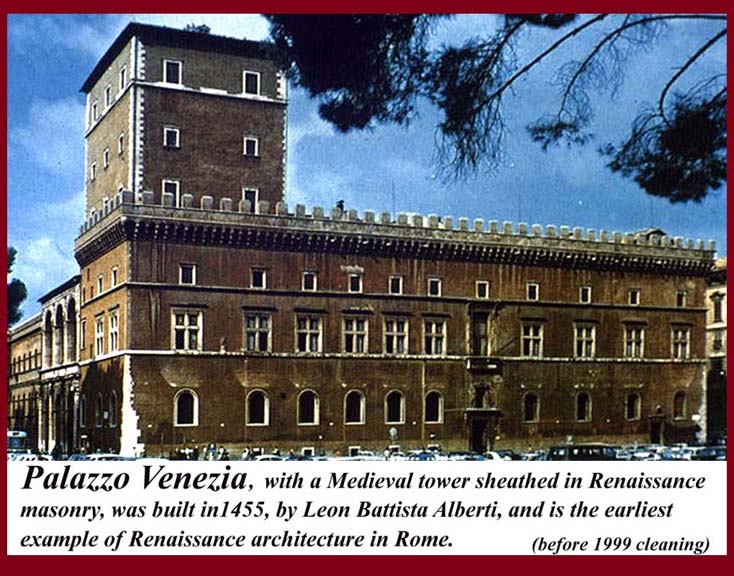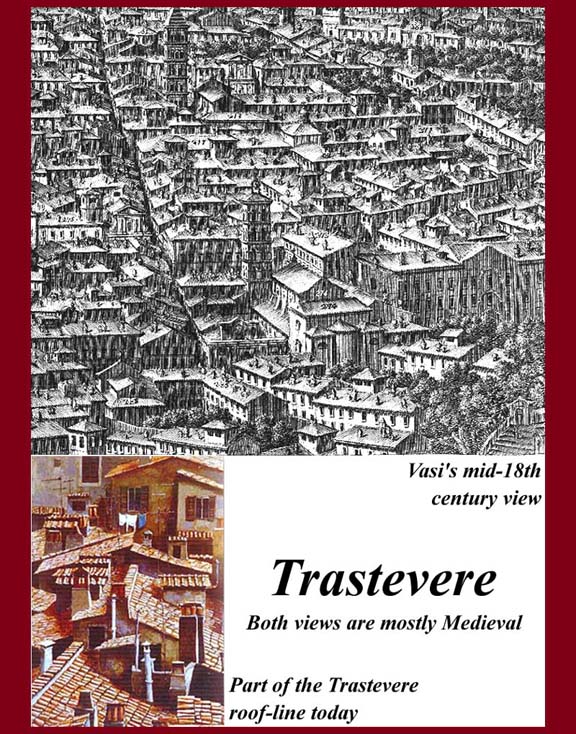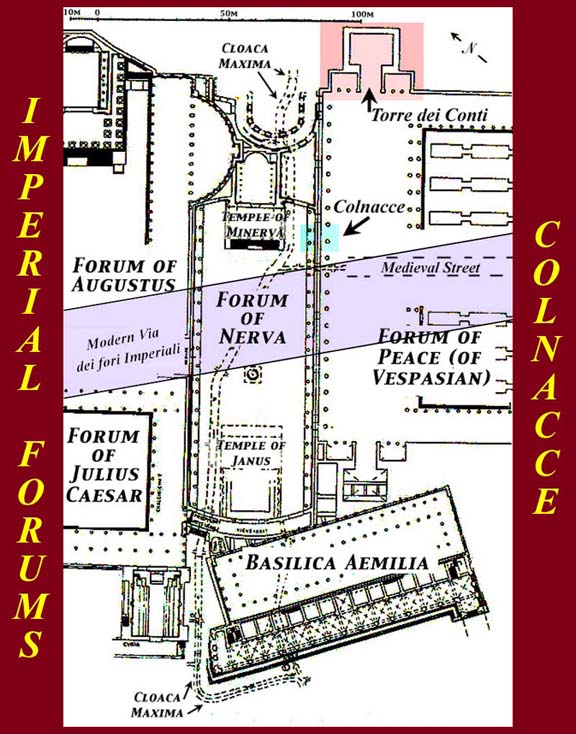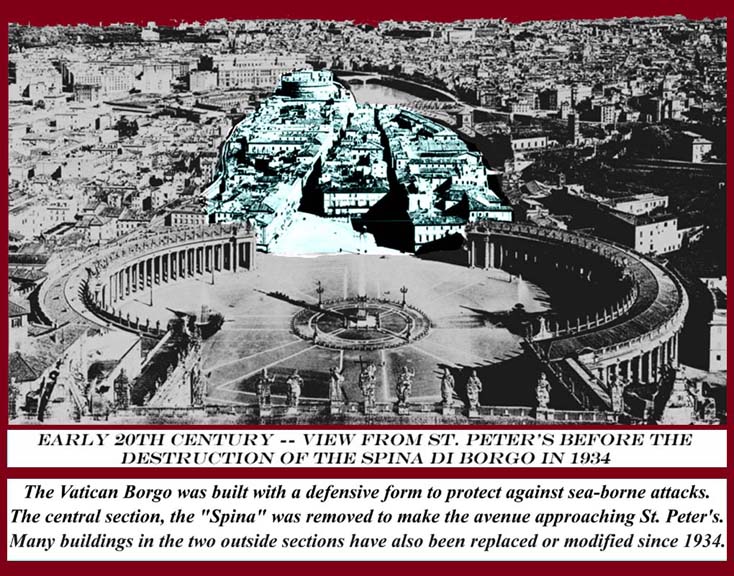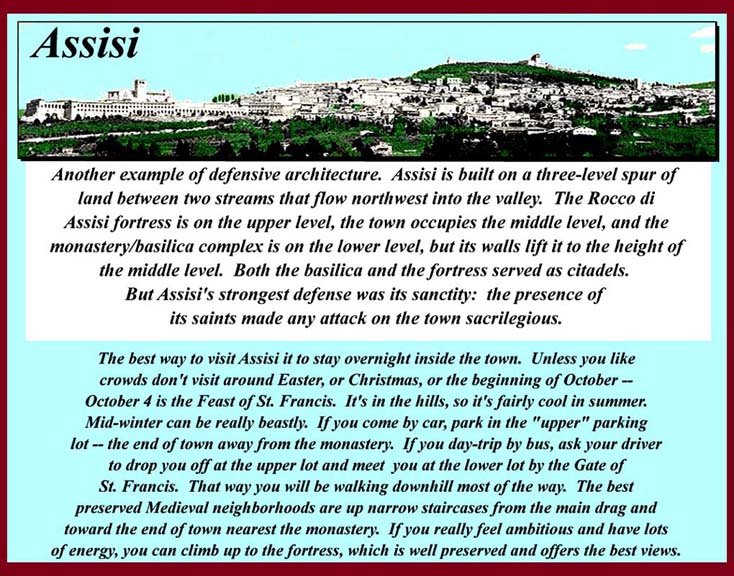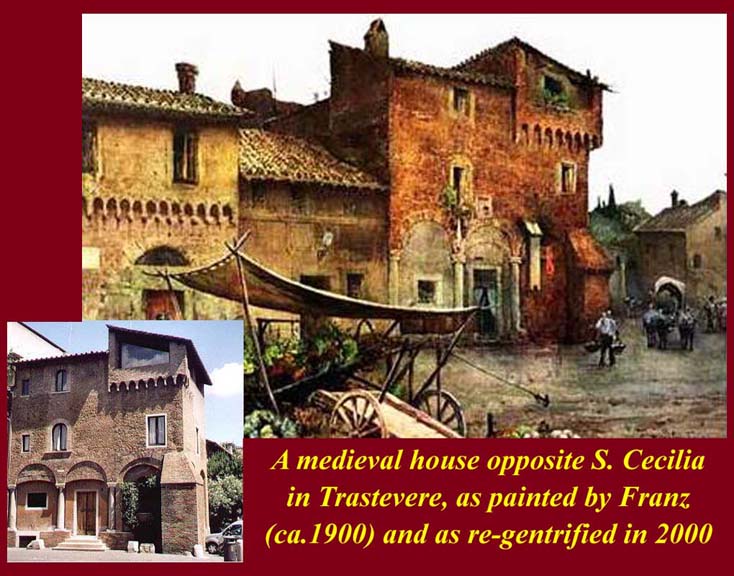Medieval Roman Architecture
Click on links or small images to view larger images for Unit 8
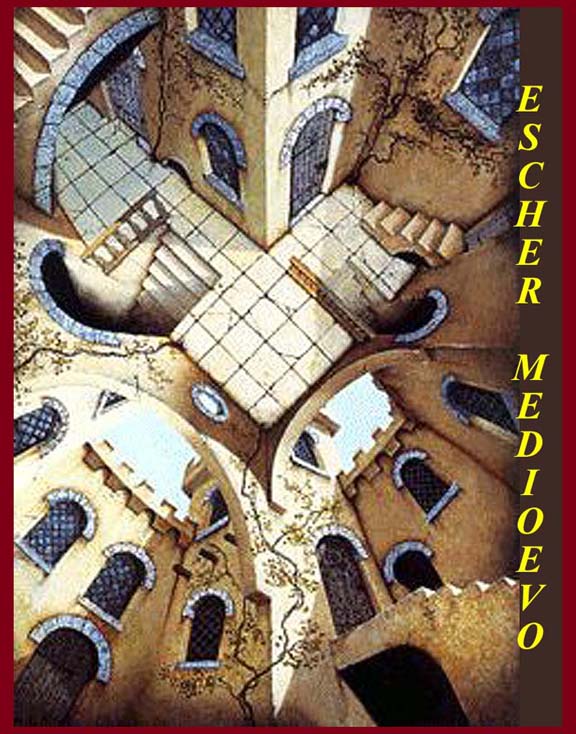
http://www.mmdtkw.org/MedRom0801EscherArch.jpg
M. C. Escher's fanciful Medieval Architecture
http://www.mmdtkw.org/MedRom0802ReligiousArch.jpg
Religious Architecture -- Romanesque v. Gothic architectural basics.
Almost all of Rome's churches (500-900 of them depending on the source you use) are built in some variation of the Romanesque style. When the rest of Europe switched to Gothic, the Romans doggedly held to the style their home-grown Romanesque.
Architectural purists, especially those from outside of Rome, draw a distinction between the first churches, which they compare to ancient Roman basilicas, and later "Romanesque" churches, which they say are different because they have a transept, i.e., the part which is perpendicular to the nave that give she church the shape of a western cross. Some of them say that there were three different stages of development: first, buildings copying ancient Roman basilicas (no transepts); second, Romanesque basilicas (the same but with transepts); and third, Gothic churches. Depending on their nationality, some architects/experts switch the timing of the second and third stages,
Others experts say that a church cannot be Romanesque if it has a flat ceiling over the nave, even if the exterior architecture looks Romanesque.
Most architectural scholars who are actually from Rome do not agree with any of these distinctions and say that a church is Romanesque either with or without a transept and that the external architecture determines that a church is Romanesque regardless of whether it has a flat or vaulted ceiling. The Roman architecture experts usually recognize only Romanesque and Gothic styles
Note that we are using the word "basilica" as an architectural definition and not as a description of how a church is put to use. The architectural definition only requires a long nave flanked by at least one narrower aisle on each side, the sections divided by columns, and even some churches without side aisles have been called basilicas. For images and descriptions of Romanesque churches, see
http://www.sacred-destinations.com/categories/romanesque and
http://en.wikipedia.org/wiki/Romanesque_architecture.
http://www.mmdtkw.org/MedRom0802aStPetersRome.jpg
One of the things we can surely say about Rome's medieval architecture is that almost all of it has disappeared. Almost all of the great medieval churches were torn down and rebuilt -- sometimes more than once -- and if they weren't rebuilt they were remodeled to the point that their "medievalness" has been swamped by renaissance and baroque overlays. A prime example is the Basilica of St. Peter where Old St. Peter's, which was built slightly after Constantine left Rome behind and effectually started Rome's medieval period, was completely replaced during the Renaissance and then the facade was added at the dawn of the baroque period. "New St. Peter's" (now at about at its 400th anniversary so not really "new") is familiar enough to our eyes that it doesn't jar our senses even though its proportions break every rule of neoclassic and renaissance and baroque architecture. That having been said, it's architecture still fits into the broad definition of the "Romanesque" style that developed during Rome's medieval period. Elsewhere in Europe and even in most places in Italy, the Gothic style predominated.
http://www.mmdtkw.org/MedRom0802bOrvietoCathedral.jpg
Romanesque-Gothic hybrid? Cathedral in Orvieto exterior -- a reasonably sized gem.
From http://www.bluffton.edu/~sullivanm/italy/orvieto/cathedral/duomo.html:
Like many medieval churches, this cathedral was sited where earlier churches had been located. On November 13, 1290 Pope Nicholas IV laid the corner stone -- where is the fourth pillar of the facade (the one sculpted with scenes from Hell). Work continued over three centuries. The original project was designed by Arnolfo di Cambio but it was altered by the Siennese architect and sculptor Lorenzo Maitani, who worked in Orvieto from 1310 until his death in 1330. Generally classified as a Gothic church, it does have Romanesque elements: the round arched central portal and the carved reliefs covering the four piers of the facade. Mosaics, as well as sculpture, decorate the facade; these, however, have been extensively restored (and sometimes changed) over the years. Also see
http://en.wikipedia.org/wiki/Orvieto_Cathedral.For Gothic architecture in general, see
http://en.wikipedia.org/wiki/Gothic_architecture
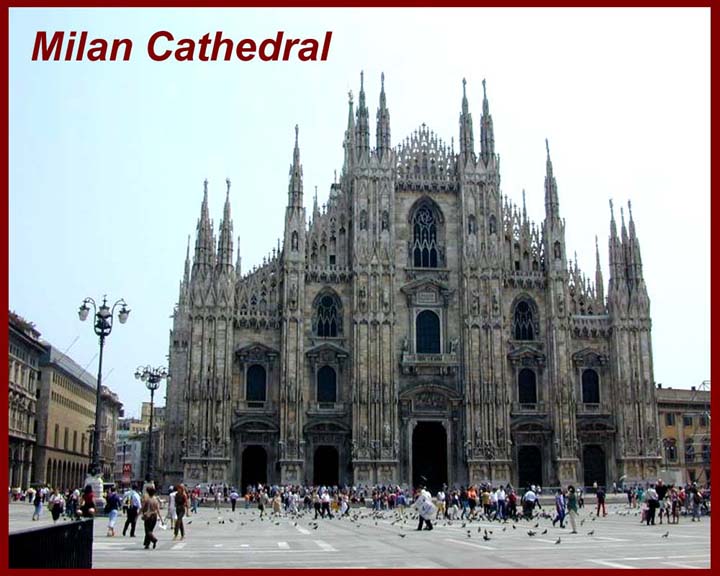
http://www.mmdtkw.org/MedRom0802cMilanCathedral.jpg
http://www.mmdtkw.org/MedRom0802c2MilanGothicCathedralInt.jpg
Gothic, Cathedral in Milan exterior -- a huge Gothic pile. Although the interior is still clearly Gothic, the ceiling, which would be stark and undecorated in northern European Gothic churches, is completely covered in frescoes, and the inter-columnar spaces are crammed full of renaissance panel-paintings -- the stained glass windows are not visible from the nave.
From http://www.bluffton.edu/~sullivanm/milancath/duomo.html:
Begun in the 1380's on a site where several churches had existed earlier, the building of this cathedral was fraught with difficulties. Over a number of years several different architects and consultants (including Leonardo and Bramante) were asked to work on the design. The cathedral is white marble, over a brick core, and has a cruciform plan. One of the largest cathedrals in the world (14,000 square yards) it was designed to accommodate 40,000 worshipers. The forest of pinnacles, the tracery panels, and the rich embellishment with statuary identifies it as Late Gothic. Closer to France than most Italian cathedrals, it borrows more directly from the French "rayonnant" style.
["Rayonnant" is an ex post facto classification that originally referred to the characteristic radiating spokes of rose windows but also includes other repetitive architectural elements in various scales. It was followed by an even more enthusiastic style called "flamboyant". Both style names are now somewhat out of favor and have been replaced by "late French Gothic". -- tkw]
Mark Twain, a greats fan of the Milan cathedral, in his Innocents Abroad:
"What a wonder it is! So grand, so solemn, so vast! And yet so delicate, so airy, so graceful! A very world of solid weight, and yet it seems ...a delusion of frostwork that might vanish with a breath!...
"The central one of its five great doors is bordered with a bas-relief of birds and fruits and beasts and insects, which have been so ingeniously carved out of the marble that they seem like living creatures-- and the figures are so numerous and the design so complex, that one might study it a week without exhausting its interest...everywhere that a niche or a perch can be found about the enormous building, from summit to base, there is a marble statue, and every statue is a study in itself...
"Away above, on the lofty roof, rank on rank of carved and fretted spires spring high in the air, and through their rich tracery one sees the sky beyond. ...(Up on) the roof...springing from its broad marble flagstones, were the long files of spires, looking very tall close at hand, but diminishing in the distance...We could see, now, that the statue on the top of each was the size of a large man, though they all looked like dolls from the street...
"They say that the Cathedral of Milan is second only to St. Peter's at Rome. I cannot understand how it can be second to anything made by human hands."Also see http://penelope.uchicago.edu/Thayer/E/Gazetteer/Places/Europe/Italy/Lombardia/Milano/Milano/Milan/churches/Duomo/Augustus_Hare.html and http://en.wikipedia.org/wiki/Milan_Cathedral.
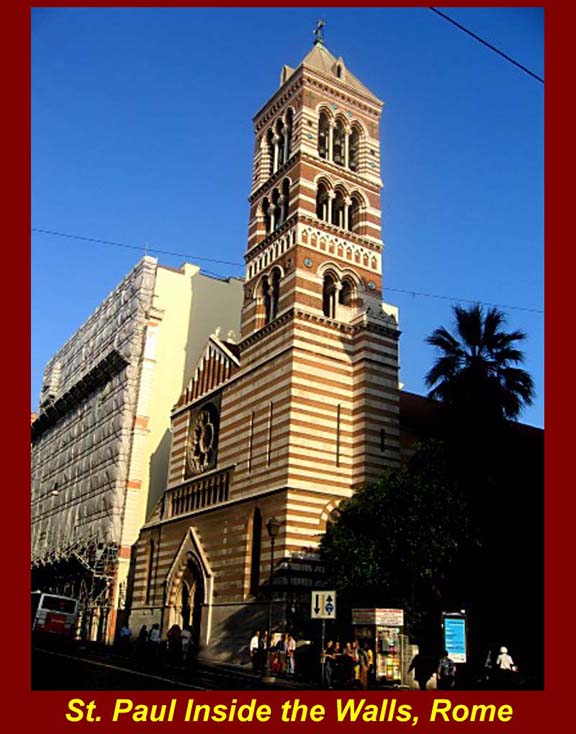
http://www.mmdtkw.org/MedRom0802dSPaoloInside.jpg
http://www.victorianweb.org/painting/bj/mosaic/1.jpg
Gothic, St. Paul Inside the Walls exterior -- 19th century. This was the first Protestant Church inside Rome's walls and one of only two Gothic churches in Rome. The Pre-Raphaelite apse mosaic, by Sir Edward Coley Burne-Jones, features J. P. Morgan, U. S. Grant, Abraham Lincoln, and Giuseppe Garibaldi, among others, in heroic garb and poses. The exterior features a Faux-Romanesque campanile.
See also http://www.victorianweb.org/painting/bj/mosaic/ for more images.
http://www.mmdtkw.org/MedRom0802eStPGothensburg.jpg
Gothic, St. Peter's Church in Gothensburg, Germany, interior -- the undecorated ribbed cross-vaulting is typical of northern European Gothic churches.
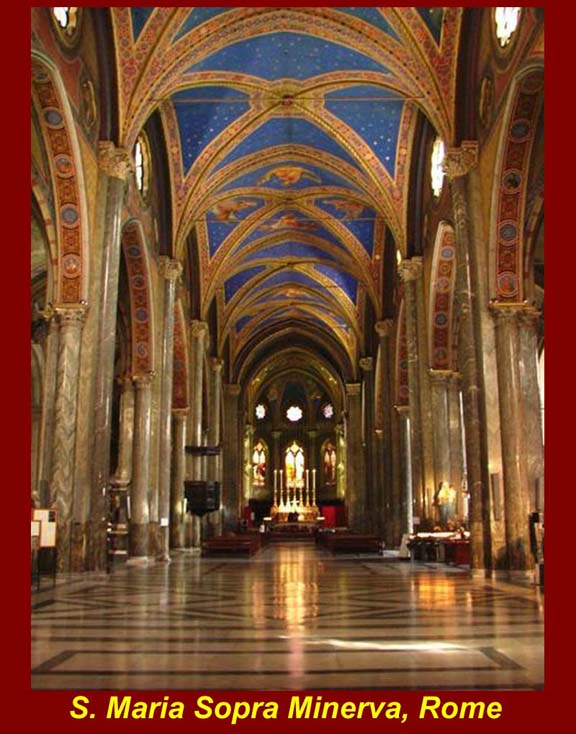
http://www.mmdtkw.org/MedRom0802fSMSopraMinerva.jpg
Santa Maria Sopra Minerva interior -- Rome's other "Gothic" church (in quotes because it is proportionally not as tall as most Gothic churches and because its interior was flamboyantly redecorated in Roman style in the 19th century -- not at all true to the Gothic type demonstrated in the image of the Gothensburg Church.
At the end of the 16th Century, Carlo Maderno gave the church a Baroque facade, but the facade was restored in the 19th century to its present neo-medieval state
See http://en.wikipedia.org/wiki/Santa_Maria_sopra_Minerva and
http://www.sacred-destinations.com/italy/rome-santa-maria-sopra-minerva .
http://www.mmdtkw.org/MedRom0802gMMaggioreInt.jpg
Romanesque Santa Maria Maggioree in Rome, interior. Founded in the 4th century, the Basilica di Santa Maria Maggiore (Basilica of Saint Mary Major) is one of the five great ancient basilicas of Rome. Its 18th-century exterior conceals one of the best-preserved Byzantine interiors in the city. The characteristic flat ceiling, according to some contemporary accounts, was decorated with the first Spanish gold from the New World, a gift from Ferdinand and Isabella.
http://en.wikipedia.org/wiki/Basilica_di_Santa_Maria_Maggiore and
http://www.sacred-destinations.com/italy/rome-santa-maria-maggiore and
http://penelope.uchicago.edu/Thayer/E/Gazetteer/Places/Europe/Italy/Lazio/Roma/Rome/churches/S.Maria_Maggiore/home.html.
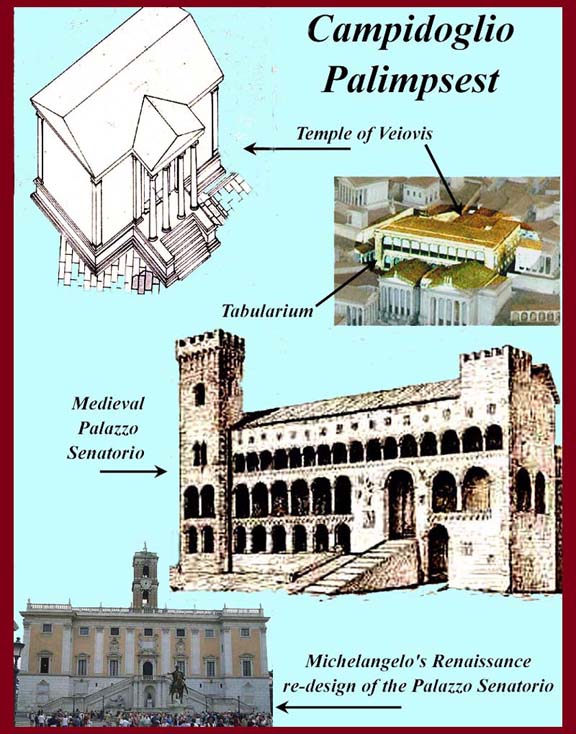
http://www.mmdtkw.org/MedRom0803CampidoPalimpsest.jpg
Campidoglio palimpsest. The part of the image that we are interested in is the building with the tower on the left end. In the Middle Ages a fortress was built over the remains of the Tabularium, and this was later transformed into the Palazzo Senatorio. Since then, the building has been used for functions associated with the city's administration.
From the Fodor's Guide: Palazzo Senatorio -- During the Middle Ages this city hall looked like the medieval town halls you can see in Tuscan hill towns, part fortress and part assembly hall. The building was entirely rebuilt in the 1500s as part of Michelangelo's revamping of the Campidoglio for Pope Paul III; the master's design was adapted by later architects, who wisely left the front staircase as the focus of the facade. The ancient statue of Minerva at the center was renamed the Goddess Rome, and the river gods (the River Tigris remodeled to symbolize the Tiber, to the right, and the Nile, to the left) were hauled over from the Terme di Costantino on the Quirinal Hill. Today, it is the regional seat of Rome's Comune administration and is not open to the public.
See http://en.museicapitolini.org/sede/piazza_e_palazzi/palazzo_senatorio.
http://www.mmdtkw.org/MedRom0804MedColosseum.jpg
The Colosseum in medieval times. The Colosseum fell into disrepair shortly after its closure in 523. In 526, the Ostrogoth Totila and his forces destroyed parts of it in order to take the valuable bronze clamps that held the stones together. After the clamps were removed, the structure, which had been partially built on a prehistoric former bed of the Tiber river, was much more prone to earthquake damage. Stones that fell were hauled away to be reused. After that, Romans freely helped themselves to the great arena's stones in order to build their houses.
In this period the Colosseum was also used as a Christian burial ground. Early Christian tombs have been found in three areas around the amphitheater: in the foundations on the north and east sides and on the exterior ground near the present entrance. The burials were probably located there in order to be close to the site of earlier martydoms.
In the Middle Ages, the Colosseum was situated on the most important pilgrim route in Rome, which led from St. Peter's to the Lateran, and a small suburb grew up around it. In this period the great arena was thought to be a Roman temple to the Sun because of the Colossus statue of Nero-turned-Helios that stood next to it.
In the lat 11th century, the Colosseum was fortified and occupied by the Frangipani family and the suburb around it became a prosperous area of Rome. However, the area later fell prey to malaria and was abandoned.
Ironically, the only thing that prevented the Colosseum from being completely destroyed -- i.e., totally quarried out for its stones -- was the belief that it was the site of Christian martyrdoms.
Large structures were built in and on the Colosseum during medieval and renaissance times, but none survive.
http://www.mmdtkw.org/MedRom0805MarcelloOrsini.jpg
Theatro Marcello -- Orsini fortress. The Theater of Marcellus was started by Julius Caesar and finished by Augustus. The Pierleoni transformed it into a fortress in Medieval times and passed it to the Savelli in the 13th century. They transformed it into a renaissance palazzo. It was acquired by the Orsini in the 18th century. Mussolini's men cleaned it up in the 1920-'30s, and the Palazzo was subdivided into ultra-high-priced condominiums in the 1990s. The Orsini are still major investors.
For more on the Theater of Marcellus, see http://www.mmdtkw.org/VTheatMarc.html.
http://www.mmdtkw.org/MedRom0806Rome1330Map.jpg
Sources of architectural information -- Medieval maps, walled Rome. Many of the maps that are available are faded, discolored, or water damaged, but modern image manipulation can bring out hidden details.
http://www.mmdtkw.org/MedRom0807Forum.jpg
Sources of architectural information -- contemporary drawings, the Forum
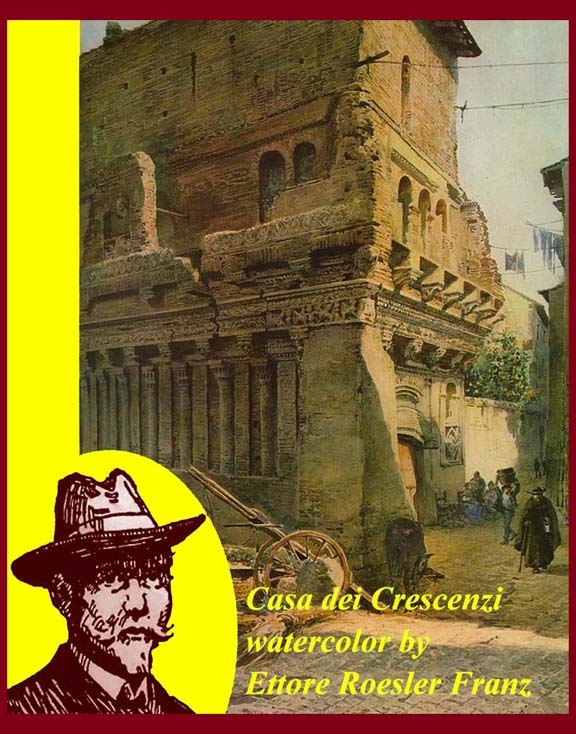
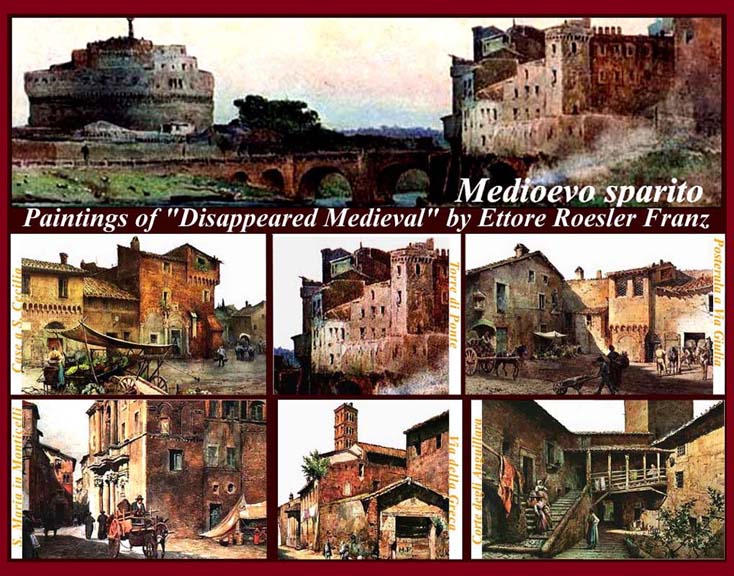
http://www.mmdtkw.org/MedRom0808RoeslerFranz.jpg
http://www.mmdtkw.org/MedRom0809MedioevoSparita.jpg
Ettore Roesler Franz paintings -- "Medievoe Sparita" (Disappearing Rome) series, ca. 1900.
Ettore Roesler Franz (May 11, 1845 - March 26, 1907) was an Italian painter and photographer of German origin. He was born in Rome and became a specialist in watercolors. His most famous works are a series of 120 watercolors named "Roma sparita" (disappeared Rome), where he portrayed with great realism parts of the city which he supposed were going to be destroyed in the effort to modernize it. These paintings are now at the Museo di Roma in Palazzo Braschi.
It turned out the Franz was mistaken, because most of what he feared would disappear is still standing. The structures have been cleaned up and turned into upscale condominiums for folks who want the look of medieval life. The interiors are almost always modernized -- floors reinforced, walls removed, modern plumbing, and, most importantly, huge kitchens with every possible modern appliance. The kitchen showplaces are almost never used; everyone always eats out or caters in.
http://www.mmdtkw.org/MedRom0810SCeciliaExt.jpg
Santa Cecilia -- medieval church with baroque additions
http://www.mmdtkw.org/MedRom0811MMaggioreEvol.jpg
S. Maria Maggiore evolution
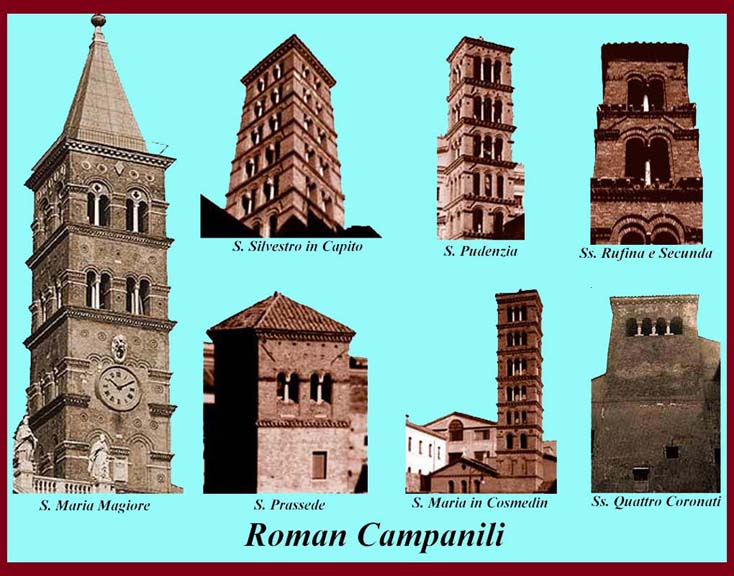
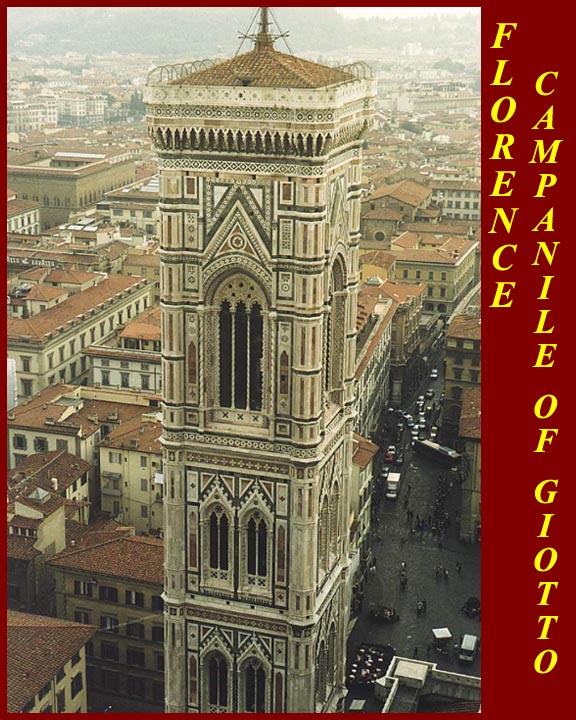

http://www.mmdtkw.org/MedRom0812RomanCampanili.jpg
http://www.mmdtkw.org/MedRom0812aGiottoCampanile 09-42-04.jpg
http://www.myrockingchairmemories.com/img/Pisa.jpg
Roman Medieval campanile (bell towers). Some later campanile were more extravagant.
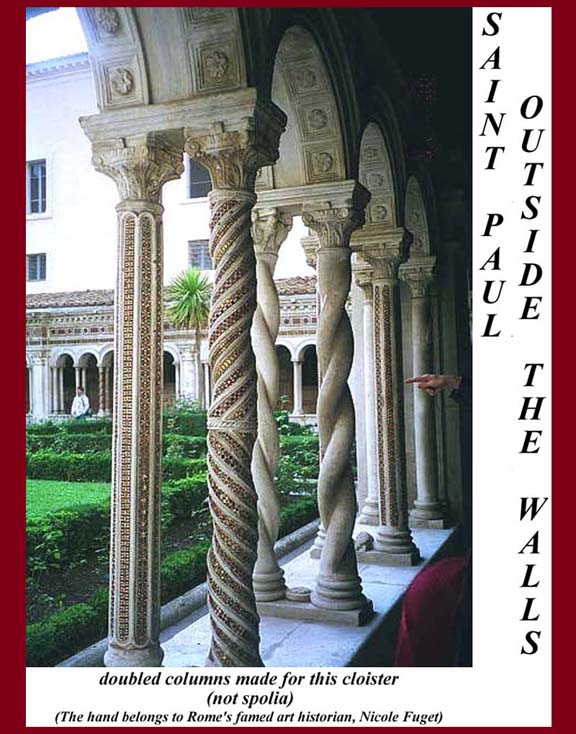
http://www.mmdtkw.org/MedRom0813PaulFuori.jpg
http://www.mmdtkw.org/MedRom0814RomeCloisters.jpg
Cloisters -- St. Paul Outside the Walls and other cloisters in Rome.
A cloister (from Latin claustrum, "enclosure") is a (usually) rectangular open space surrounded by covered walks or open galleries, with open arcades on the inner side, running along the walls of buildings and forming a quadrangle or garth. The attachment of a cloister to a cathedral or church, commonly against a warm southern flank, usually indicates that it is (or once was) part of a monastic foundation.
See http://en.wikipedia.org/wiki/Cloister.
For the Metropolitan Museum Cloisters Museum in New York, see
http://www.inetours.com/New_York/Pages/Cloisters.html.
http://www.mmdtkw.org/MedRom0815AssisiFranciscan.jpg
The Franciscan complex in Assisi is one of Italy's great late medieval assemblages. In the centuries since it was built (begun 1228), numerous flimsy extraneous structures were tacked on to the outer walls. Almost all were destroyed or badly damaged in the 1997 earthquakes, and the basilica restorers tore down the rest and returned the complex to its medieval appearance.
See http://eng.archinform.net/projekte/11603.htm for an architectural study of the site.
http://www.mmdtkw.org/MedRom0816AssisiQuake.jpg
The 1997 Assisi earthquake -- inside the Church of St Francis.
http://www.mmdtkw.org/MedRom0817AssisiAerial.JPG
Aerial view of the Franciscan complex -- more than what Francis thought was necessary.
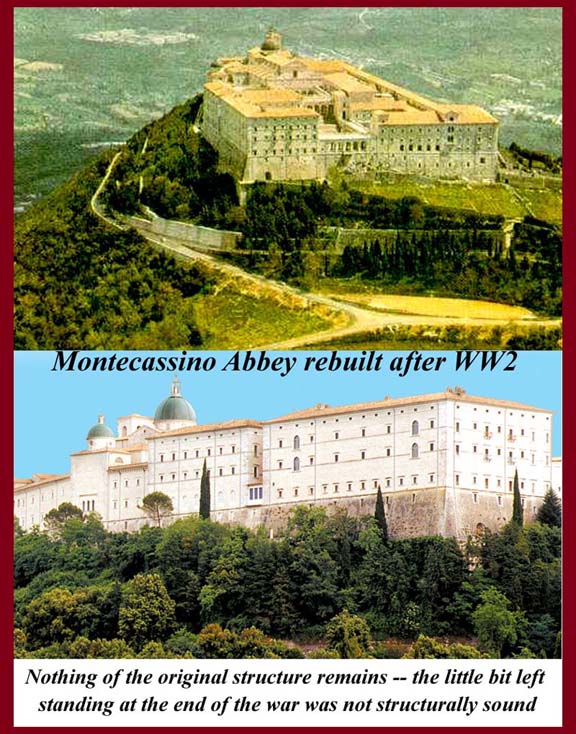
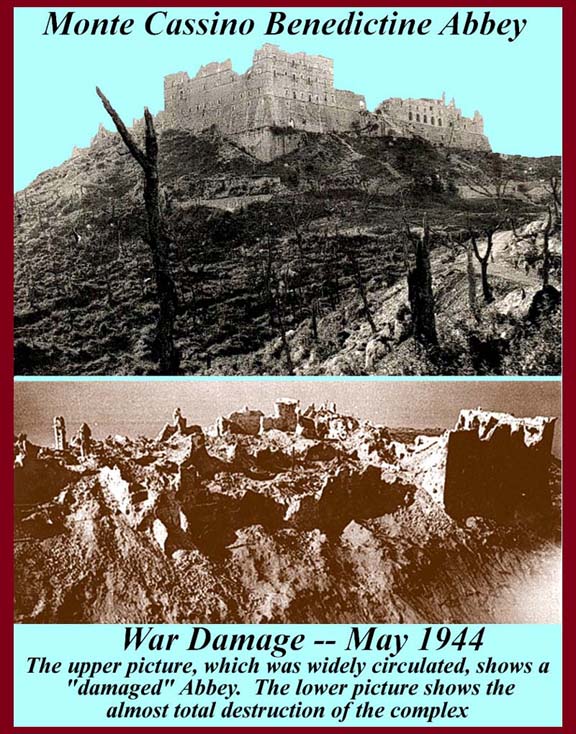
http://www.mmdtkw.org/MedRom0818CassinoReconst.jpg
http://www.mmdtkw.org/MedRom0819CassinoDamage.jpg
http://www.mmdtkw.org/MedRom0820CassBramanteClois.jpg
Reconstructed Monte Cassino. War damage to Monte Cassino. Bramante designed cloister at Monte Cassino, reconstructed. The medieval monastery was destroyed during the Second World War in a battle that is still controversial.
For information on the monastery and on the battle, see
http://en.wikipedia.org/wiki/Monte_Cassino
http://en.wikipedia.org/wiki/Battle_of_Monte_Cassino
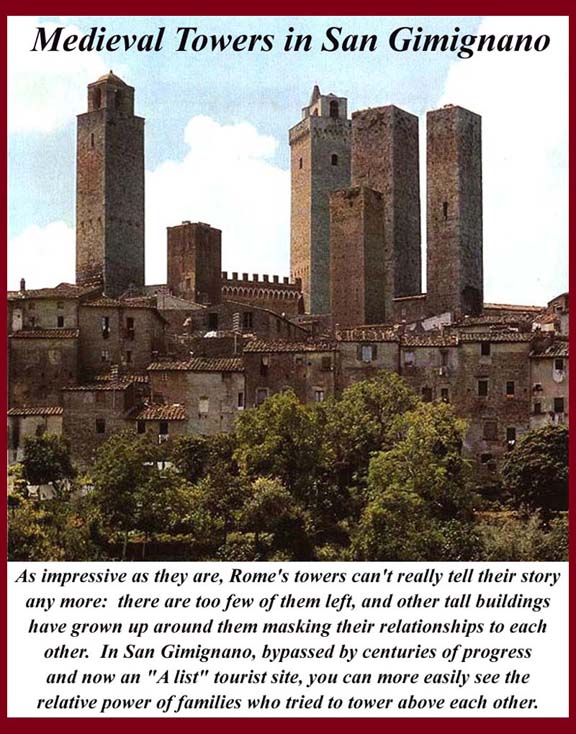
http://www.mmdtkw.org/MedRom0821GimignanoTowers.jpg
http://www.mmdtkw.org/MedRom0821xBolognaTowers.jpeg
Medieval fortress towers in San Gimignano are better preserved than those in other Italian towns and cities including Rome. Even in San Gimignano, only fourteen of the original 72 towers are still standing. The structures were built both for offensive and defensive purposes. They would have only one stout and defensible door, and lower storeys were windowless. Height gave an advantage to both offensive and defensive weaponry; the object was to "tower over' your enemies.
For more on medieval Italian towers, see
http://goeurope.about.com/od/italy/a/medieval_towers.htm.
http://www.mmdtkw.org/MedRom0822MedArchSeverus.JPG
Roman Towers -- Arch of Septimius Severus in the forum with fortress tower and crenelations.
http://www.mmdtkw.org/MedRom0823TorreMilizie.jpg
Roman Towers -- The Torre delle Milizie ("Tower of the Milices") is a tower in Rome, Italy, next to the Trajan's Market in the Imperial fora.
One of the main medieval monuments of the city, the tower is on a square plan, its base sides measure 10.5 x 9.5 m, and it currently stands at almost 50 meters. The earthquake of 1348 caused both the crumbling of an upper floor and the slightly tilting of the structure. In origin it belonged to a series of fortified edifices grouped around a court, in which the tower was located.
It gained the popular nickname of "Nero's Tower" from a tradition that it originated as a Roman construction from which Emperor Nero watched the fire of Rome - this is derived from the classical account that he watched from a tower in the Gardens of Maecenas, though more trustworthy accounts place him out of town, at Antium at the time. Its actual construction probably dates to the time of Pope Innocent III (1198-1216).
At the end of the 13th century the tower was a possession of the powerful Annibaldi family, who were followed by the Prefetti di Vico and by the Caetani, Pope Boniface VIII's family. Under the Caetani the fortified quarter was enlarged and strengthened, probably rivaling with Castel Sant'Angelo as Rome's main fortress. When Henry VII of Luxembourg came to the city for his coronation as Holy Roman Emperor (May-June 1312), he chose the Torre delle Milizie as the base for his Guelph supporters. Twenty years later the tower was ceded to the Conti. During their ownership Raphael, in his role as curator of the antiquities of the city, cited the tower as an example of an edifice built re-using antique parts. The Conti held it until 1619, when it was acquired by the nuns of the neighbouring convent (later demolished) of Santa Caterina a Magnanapoli.
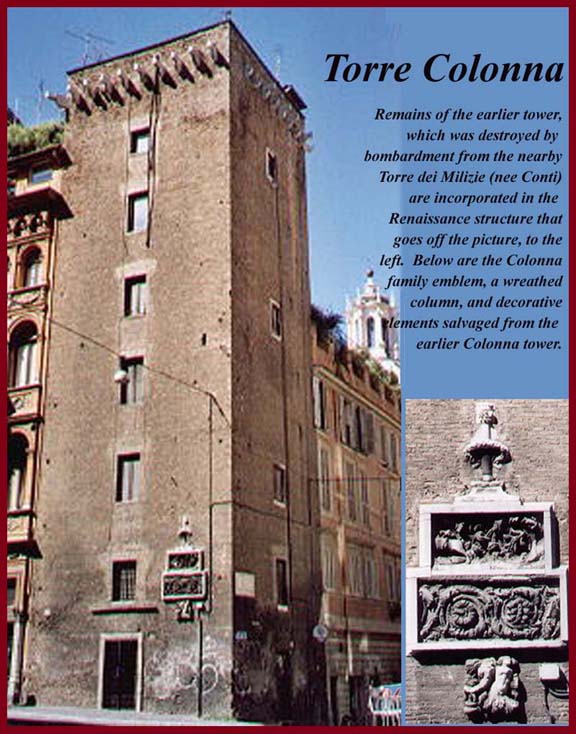
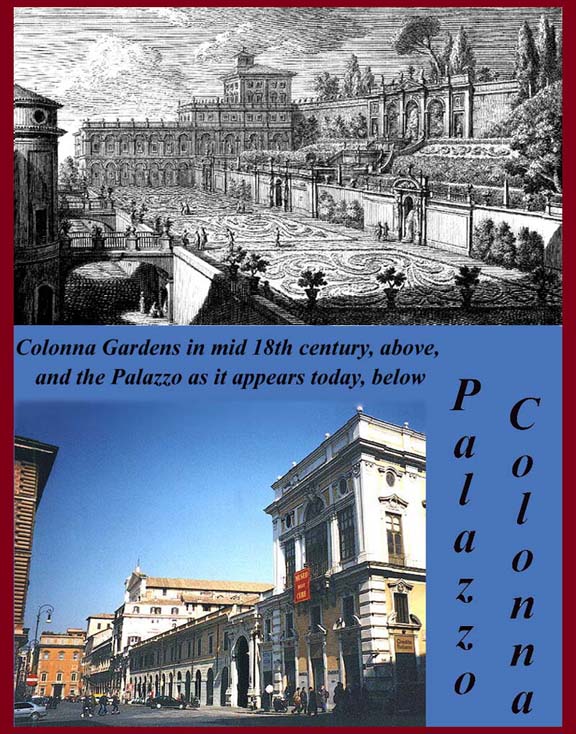
http://www.mmdtkw.org/MedRom0824TorreColonna.jpg
http://www.mmdtkw.org/MedRom0825ColonnaGarden.jpg
Roman Towers -- Tower of the Colonna -- a replacement for one destroyed by the Conti. Like many of Rome's towers, this one is hardly noticeable, because it is incorporated into a structure of approximately the same height. The Renaissance Colonna palazzo is nearby. The tower on the corner of the Palazzo was really a Belvedere, which was called by the Colonna family their Cafe -- where they had their coffee while looking out over the city. The Colonna still own and live in their Palazzo, part of which is open to the public on Saturday mornings. The 17th century Sala Grande of the Palazzo is available for rental for parties (see http://www.galleriacolonna.it/) The garden behind the palazzo is also available for garden parties.
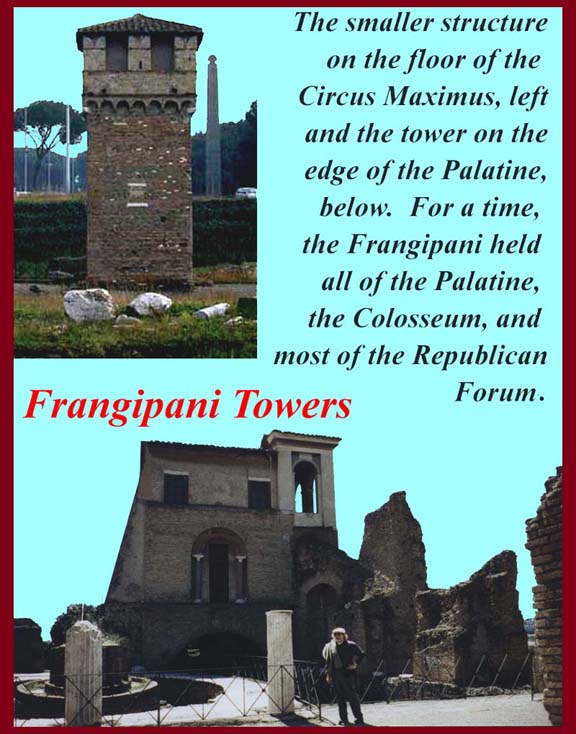
http://www.mmdtkw.org/MedRom0826FrangipaniTowers.jpg
Roman Towers -- Frangipani towers. For a time, the Frangipani family held and fortified the Colosseum, the Circus Maximus, and one whole end of the Palatine Hill. Of course, they needed towers. The Frangipani were allied with and intermarried with the Orsini and were the chief adversaries of the Pierleone in the struggles for power among the Roman noble families. It was, in fact, these struggles and the general lawlessness that they entailed that encouraged the Popes to decamp to Avignon.
http://www.mmdtkw.org/MedRom0827TorreScimmia.jpg
Roman Towers -- Monkey tower -- a dubious legend. Rome, like almost every other Roman city has a monkey tower. According to legend, the newborn baby of the noble owner's family was taken to the top of the tower by the family's pet monkey. Only after fervent prayer did the monkey relent and bring the child back to safety. The father then put a lamp at the top of the tower which he vowed to keep lit in perpetuity. This seems to have happened just about everywhere and the story is always assigned to some local tower.
This tower, now part of the Palazzo Scapucci in Rome's Via Portoghese, was built by the Crescenzi who subsequently lost it to the Frangipani family.
http://www.mmdtkw.org/MedRom0828TorreVenezia.jpg
Roman Towers -- Medieval tower remodeled in the renaissance Palazzo Venezia facing onto Rome's Via del Corso. The Palazzo was built around the preexisting Torre della Biscia medieval tower. Mussolini set up his offices in palazzo Venezia and gave speeches from the balcony above the door. It was the seat of the Italian Fascist government from 1929 to 1944.
For more information on Palazzo Venezia, see http://en.wikipedia.org/wiki/Palazzo_Venezia.
http://www.mmdtkw.org/MedRom0829Trastevere.jpg
Medieval housing in Trastevere -- where it still survives in Rome. There are also medieval residential structures along Via dei Coronari and adjacent streets between Piazza Navona and Ponte Sant'Angelo and on streets around the Campo de Fiori. All three areas are becoming gentrified, but the Medieval structures are being refurbished rather than being torn down.
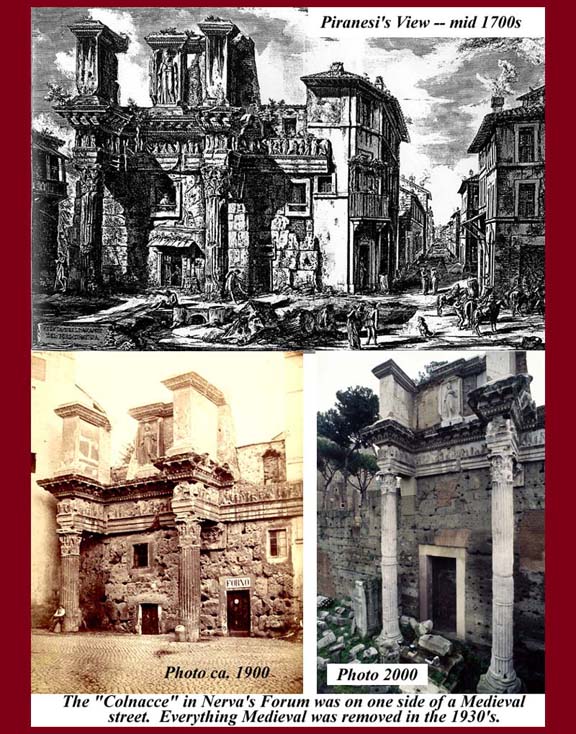
http://www.mmdtkw.org/MedRom0830ColnacceStreet.jpg
http://www.mmdtkw.org/MedRom0831ColnacceForaMap.jpg
Street behind the "Colnacce" -- One large area of medieval buildings was, in fact, demolished in the20th century as part of Mussolini's project to build the Via dei Fori Imperiali between Piazza Venezia and the Colosseum. Medievalists and ex post facto preservationists decry the destruction, but in fact, the whole neighborhood was a pestilential slum. The "colnacce" was a set of pillars from the Forum of Commodus/Nerva which framed a gate into Vespasian's Forum of Peace.
For more on the Via dei Fori Imperiali project, see
https://en.wikipedia.org/wiki/Via_dei_Fori_Imperiali
and http://romeonrome.com/2015/02/the-life-and-death-of-via-dei-fori-imperiali-1932-2015/.
For photos and paintings of the demolition and excavation works and of recovered artwork, see
http://foto.ilsole24ore.com/SoleOnLine4/Tempo%20libero%20e%20Cultura/2008/fori-imperiali/fori-imperiali.php.
http://www.mmdtkw.org/MedRom0832BorgoSPietro.jpg
Borgo S. Pietro photo showing the "spina" housing blocks removed by Mussolini's men in 1934.
After the Saracens sacked Rome in 846 during the reign of his predecessor, Pope Leo IV fortified the area around St Peters and the neighborhood directly in from of Piazza San Pietro by turning it into a "borgo". Outside wall of all the houses were connected and reinforced so that "Borgo San Pietro" could only be entered by passing through the fortifications at Castel Sant'Angelo.
To see how Mussolini's Via della Conciliazione (construction 1936-50) modified the Borgo by taking out the central strip of medieval buildings, see https://upload.wikimedia.org/wikipedia/commons/d/d6/Via_della_Conciliazione_dal_cupolone.jpg.
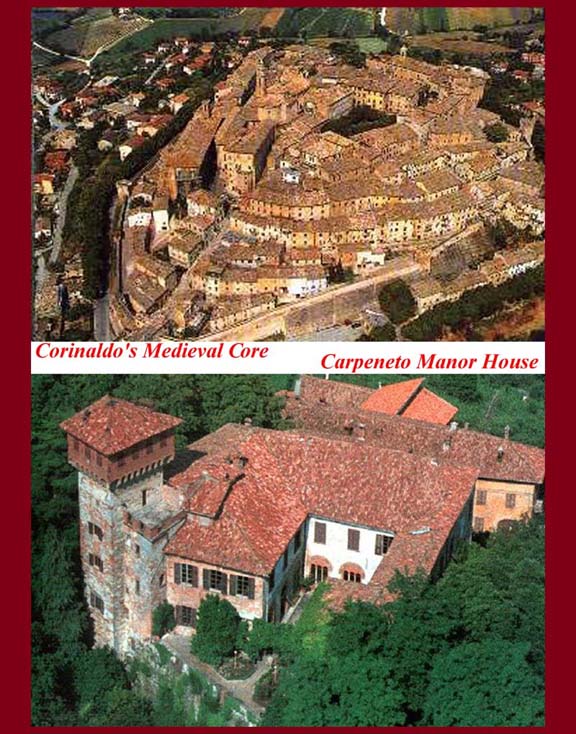
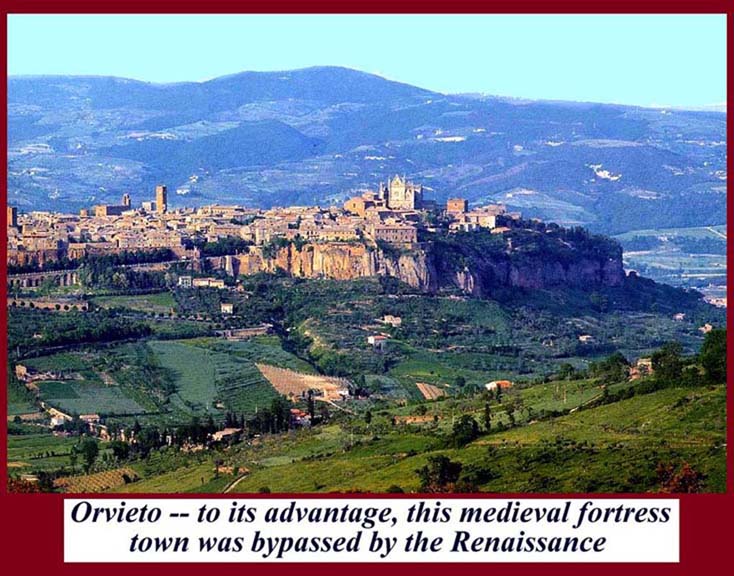
http://www.mmdtkw.org/MedRom0833CorinaldoCarpenet.jpg
http://www.mmdtkw.org/MedRom0835Orvieto.jpg
http://www.mmdtkw.org/MedRom0836AssisiDefensible.jpg
Fortified town and rural manor house fortress. Just like in football, the key is defense. Medieval builders and town planners were masters of defensive design, either in Rome and other cities or in smaller towns and manor houses.
http://www.mmdtkw.org/MedRom0834CaseSCecilia.jpg
Houses across fro Santa Cecilia in Trastevere -- gentrified again. Houses of the gentry in Trastevere and medieval hoses elsewhere in Rome were heavily constructed and had defensive feature. They would have had no real chance of resistance, however, if attacked by the massed minions of a noble house. Your only real defense if you were a smallholder would not be architectural but rather would be social. Having a powerful patron in one of the noble families would help -- at least until the noble patron was defeated in the constant intramural battles.
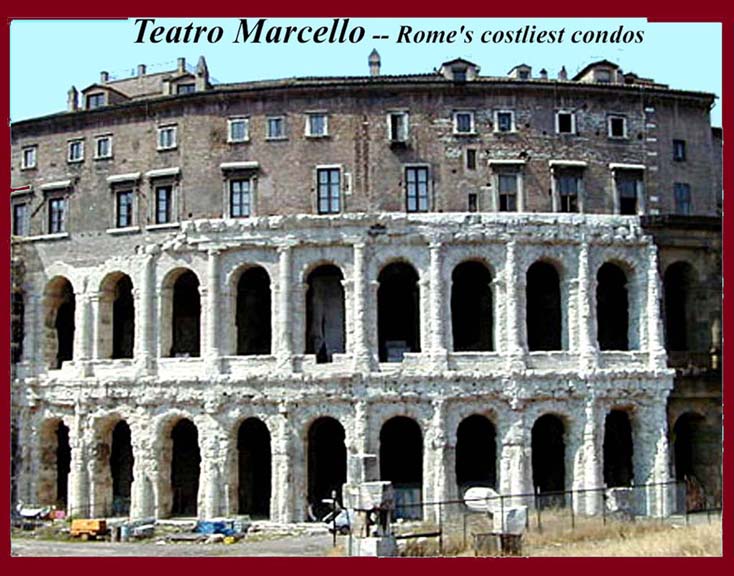
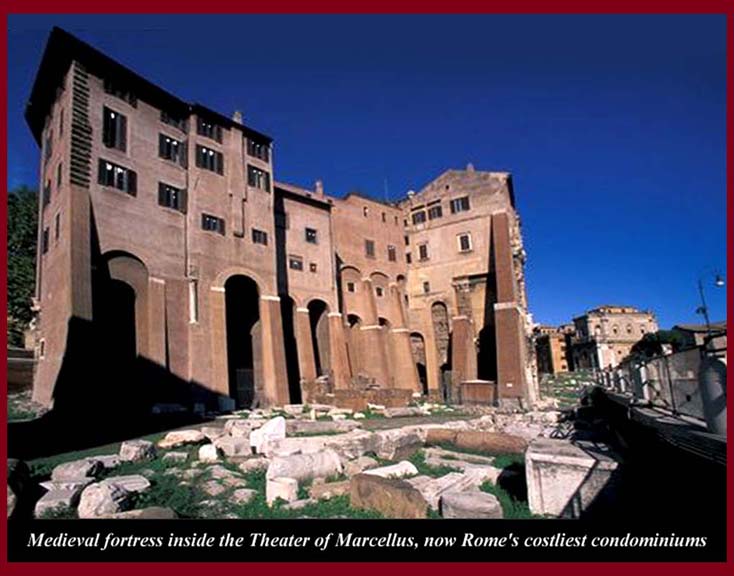
http://www.mmdtkw.org/MedRom0837MarcelloCondos.jpg
http://www.mmdtkw.org/MedRom0838MarcelloOrsini.jpg
Teatro Marcello Orsini fortress -- now condos. We can see what kind of fortifications were designed by the architects hired by the rich folks.

